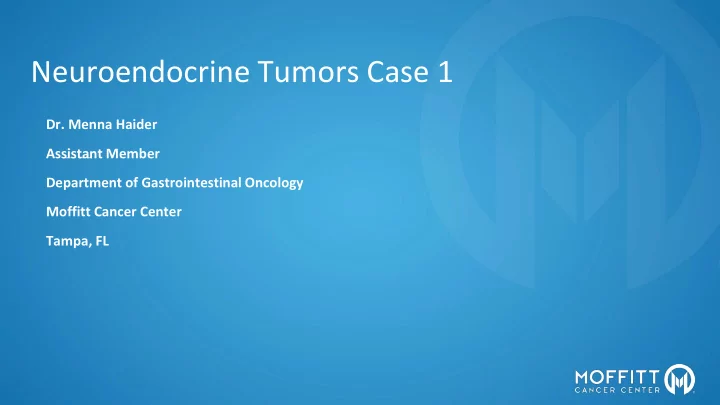

Neuroendocrine Tumors Case 1 Dr. Menna Haider Assistant Member Department of Gastrointestinal Oncology Moffitt Cancer Center Tampa, FL
Disclosures • None
Clinical Question • Which of the following patients are at risk of developing diarrhea due to malabsorption? A) A 65 year old man with a low grade pancreatic NET in the tail of the pancreas B) A 45 year old woman who underwent a Whipple surgery for resection of a duodenal low grade NET (T3N2) C) A 50 year old woman who underwent partial gastrectomy for a resection of gastric NET D) A 38 year old woman who underwent partial hepatectomy for debulking of metastatic small bowel NET E) All of the above
Case 1 • A 60 year old man presents for consultation to discuss management of diarrhea • He was diagnosed with well differentiated Grade 2 NET of the cecum after presenting with progressive abdominal pain and loose stools • At diagnosis, he had metastatic disease to the liver as well as mesenteric lymphadenopathy and a right pelvic mass • His treatment history includes: • Octreotide LAR 30mg every 28 days • Surgical debulking: omentectomy, ileocolic resection, resection of 6cm right pelvic mass and cholecystectomy • He continues on octreotide LAR 30mg every 28 days • Screening transthoracic echo normal
Question 1 • Which of the following could be contributing to the patient’s diarrhea? A. Small intestinal bacterial overgrowth (SIBO) B. Carcinoid syndrome C. Excess bile acids entering the colon D. Side effect of somatostatin analogue E. All of the above
Answer and Explanation E. All of the above • The patient has multiple risk factors for diarrhea. • He may have carcinoid syndrome due to the metastatic NET • SSA can cause loose stools or diarrhea at a reported rate of 60%, primarily due to pancreatic malabsorption • Prior intestinal surgery can predispose him to SIBO • Right hemicolectomy and cholecystectomy can result in excess bile acid entering the colon • Loss of part of the colon can disrupt reabsorption of fluids
• The diarrhea is described as 8-10 watery non-bloody bowel movements • He does not have flushing • The diarrhea improves to 3-4 bowel movements after octreotide LAR is administered but returns one week prior to the next injection • He does not gain satisfactory control with loperamide
What other information would you obtain? • Behavior: How is he taking supportive medications? Is there a particular food that exacerbates the diarrhea? • Labs: CBC, CMP, Urine 5HIAA • Restaging: CT, Ga-68 PET
Next steps in Assessment • CBC and CMP normal • Urine 5-HIAA 85 (nl 0-15) • CT 3-phase abdomen/pelvis: no progression in known liver masses or right pelvic mass
Discussion points with patient regarding symptom management • Added a bile sequestrant (cholestyramine) due to history of right hemicolectomy and cholecystectomy • Discussed telotristat for treating diarrhea secondary to carcinoid syndrome • Due to the timing of diarrhea, we decreased the interval of octreotide LAR from 28 days to 21 days • Ordered Ga68 PET for future treatment decisions
Question 2 • Which of the following is NOT correct about telotristat: A. It has been shown to reduce bowel movement frequency in carcinoid syndrome compared to placebo B. It has been shown improve progression free survival for small bowel NETs C. It has been shown to reduce urine 5-HIAA over time D. It causes more nausea at higher dose compared to 250mg PO TID
Answer and Explanation B. It has been shown to improve progression free survival for small bowel NETs • TELESTAR trial was a three arm study comparing SSA plus placebo vs SSA plus two doses of telotristat (250mg and 500mg) • Telotristat was shown to improve frequency of bowel movements over a 12 week period • It was shown to reduce urine 5HIAA by 40 and 57.7mg at dose of 250mg and 500mg, respectively • The higher dose was associated with increased nausea
Conclusions • NET patients are at risk for diarrhea due to multiple factors • Diarrhea is a major quality of life issue for these patients • Assessing for malabsorption, prior surgical treatments and medication side effects can help the clinician understand underlying etiologies • Patient education regarding medication management is important • Multiple resources are available to the clinician to address diarrhea
Recommend
More recommend